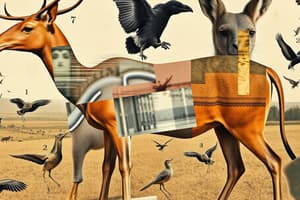Podcast
Questions and Answers
What is the definition of Kingdom Animalia?
What is the definition of Kingdom Animalia?
- Multicellular and autotrophic, with asexual reproduction
- Single-celled and autotrophic
- Multicellular and heterotrophic, with asexual reproduction
- Multicellular and heterotrophic, with mostly sexual reproduction (correct)
What are the characteristics of Phylum Porifera?
What are the characteristics of Phylum Porifera?
Sponges; aquatic animals; asymmetrical bodies; 2 cell layers; reproduction asexual and sexual.
What defines Phylum Echinodermata?
What defines Phylum Echinodermata?
Water vascular system; internal skeleton; spiny skin; symmetrical; examples include starfish, sea urchins, and sea cucumbers.
List the characteristics of Phylum Annelida.
List the characteristics of Phylum Annelida.
What are the key features of Phylum Nematoda?
What are the key features of Phylum Nematoda?
Describe the characteristics of Phylum Cnidaria.
Describe the characteristics of Phylum Cnidaria.
What is the defining feature of Phylum Arthropoda?
What is the defining feature of Phylum Arthropoda?
What are the characteristics of Class Crustacea?
What are the characteristics of Class Crustacea?
List the key features of Class Arachnida.
List the key features of Class Arachnida.
What defines Class Insecta?
What defines Class Insecta?
What are the characteristics of Phylum Mollusca?
What are the characteristics of Phylum Mollusca?
Describe Class Bivalvia.
Describe Class Bivalvia.
What are the key features of Class Gastropoda?
What are the key features of Class Gastropoda?
Describe Class Cephalopoda.
Describe Class Cephalopoda.
What are the characteristics of Phylum Chordata?
What are the characteristics of Phylum Chordata?
What does Subphylum Vertebrata include?
What does Subphylum Vertebrata include?
Describe Class Chondrichthyes.
Describe Class Chondrichthyes.
What defines Class Osteichthyes?
What defines Class Osteichthyes?
What are the key features of Class Amphibia?
What are the key features of Class Amphibia?
Describe Class Reptilia.
Describe Class Reptilia.
What defines Class Aves?
What defines Class Aves?
What are the characteristics of Class Mammalia?
What are the characteristics of Class Mammalia?
Study Notes
Kingdom Animalia
- Multicellular organisms that are heterotrophic.
- Reproduction primarily occurs through sexual means.
Phylum Porifera
- Includes sponges, aquatic animals with asymmetrical body structures.
- Composed of two cell layers, capable of asexual and sexual reproduction.
Phylum Echinodermata
- Characterized by a water vascular system and internal skeleton.
- Features spiny skin and symmetry; examples include starfish, sea urchins, and sea cucumbers.
Phylum Annelida
- Known as segmented worms, possessing a complete digestive tract.
- Features a closed circulatory system and a ventral nervous system.
Phylum Nematoda
- Comprises roundworms with long, cylindrical bodies.
- Equipped with a digestive system featuring a mouth and anus; most are parasitic.
Phylum Cnidaria
- Aquatic organisms with symmetrical, saclike bodies and two cell layers.
- Exhibits two body forms: medusa and polyp; includes jellyfish, corals, and anemones, reproducing sexually.
Phylum Arthropoda
- Characterized by segmented bodies and jointed appendages.
- Possesses an exoskeleton for support and protection.
Class Crustacea
- Distinctive for having two pairs of antennae; primarily aquatic.
- Respiration occurs via gills; examples include lobsters and crabs.
Class Arachnida
- Lacks antennae; comprises two body regions and four pairs of legs.
- Includes species such as spiders and scorpions.
Class Insecta
- Features include one pair of antennae, three body regions, and three pairs of legs.
- Many insects have two pairs of wings; examples are flies, ants, and beetles.
Phylum Mollusca
- Soft-bodied, unsegmented creatures with a muscular foot and mantle.
- Possesses a radula and well-developed digestive, circulatory, and nervous systems.
Class Bivalvia
- Notable for a two-part hinged shell and absence of a head or radula.
- Examples include clams, oysters, and mussels.
Class Gastropoda
- Characterized by a head with tentacles; most possess a spiraled shell.
- Includes snails and slugs among its members.
Class Cephalopoda
- Features a large head surrounded by arms or tentacles.
- Shell may be absent, internal, or external; highly developed nervous systems found in species like octopuses and squids.
Phylum Chordata
- Defined by the presence of a notochord, paired gill slits, and a dorsal nerve cord.
Subphylum Vertebrata
- Distinguished by an enlarged brain and vertebral column encasing the dorsal nerve cord.
Class Chondrichthyes
- Comprises fish with skeletons made of cartilage, equipped with movable jaws and fins.
- Sharks serve as a prominent example.
Class Osteichthyes
- Features a bony skeleton, movable jaws, overlapping scales, paired fins, and an air bladder.
- Includes species like salmon, trout, and carp.
Class Amphibia
- Moist, smooth skin lacking scales; possesses four limbs.
- Requires water for reproduction; examples include frogs and toads.
Class Reptilia
- Notable for dry, scale-covered skin and four limbs.
- Internal fertilization occurs, with organisms having lungs and a three-chambered heart; includes turtles and alligators.
Class Aves
- Birds with feathers; front limbs adapted as wings.
- Eggs are encased in hard shells, with a four-chambered heart and warm-blooded metabolism; includes robins and chickens.
Class Mammalia
- Mammals nourish their young with milk, characterized by fur or hair covering.
- Possesses a four-chambered heart and is warm-blooded; notable examples include humans, mice, and tigers.
Studying That Suits You
Use AI to generate personalized quizzes and flashcards to suit your learning preferences.
Description
Explore the diverse world of the Animal Kingdom with this set of flashcards focused on key classifications. Each card highlights critical characteristics of various phyla, from sponges to echinoderms. Perfect for biology students looking to enhance their understanding of animal classification.




